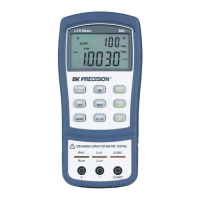55
be measured at higher frequencies such as 1 kHz or 10 kHz. However, a 120 Hz test signal is
used to measure inductors that are used for applications such as filter chokes in power
supplies, in which are typically operated at 60 Hz AC (in U.S.) with 120 Hz filter frequencies.
In general, inductors below 2 mH should be measured at 1 kHz frequency while inductors above
200 H should be measured at 120 Hz.
In all cases, it is best to check with the manufacturer’s data sheet in order to determine the
best test frequency to use for measurement.
Selecting Series or Parallel Mode
Just as test frequency can greatly affect measurement results, selecting between series or
parallel measurement mode can also affect the accuracy of the meter, especially for capacitive
and inductive components. Below are some recommendations to consider.
Capacitance
For most capacitance measurement, selecting parallel mode is the best. Hence, the meter
defaults to this mode when selecting capacitance mode. Most capacitors have very low
dissipation factor (high internal resistance) compared to the impedance of the capacitance. In
these cases, the paralleled internal resistance has negligible impact upon the measurement.
Though in some cases, series mode would be preferred. For instance, measuring a large
capacitor would require using series mode for optimal reading. Otherwise, the meter may
show the reading results as out of accuracy or erroneous. Series mode is use because large
capacitors often have higher dissipation factor and lower internal resistance.
Inductance
For most inductance measurement, selecting series mode is the best. Hence, the meter
defaults to this mode when selecting inductance mode. This is because in this mode, accurate
Q (quality factor) reading can be obtained from reading low Q inductors and ohmic losses are
significant.
Though in some cases, parallel mode would be preferred. For example, iron core inductors
operating at higher frequencies where hysteresis and eddy currents become significant would
require measurement in parallel mode for optimal results.
Accuracy Discrepancies
In some special cases, inaccuracies may occur in the measurement of capacitive, inductive, and
resistive components.

